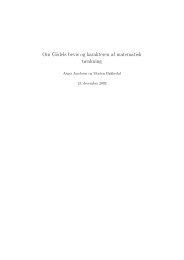Master Dissertation
Master Dissertation
Master Dissertation
You also want an ePaper? Increase the reach of your titles
YUMPU automatically turns print PDFs into web optimized ePapers that Google loves.
Expected properties of the S-matrix.<br />
1 Unitarity i.e. S(g) −1 = S(g) ∗ . That is<br />
˜Tn(x1, . . . , xn) = Tn(x1, . . . , xn) ∗ .<br />
Fixme: this is not enough according to page 162 probably not important for<br />
this project.<br />
2 Translational invariance. Let U(a, 1) be the unitary translation operator<br />
in the Fock space F, that is<br />
Then we require<br />
(U(a, 1)Φ)j(x) = Φj(x1 + a, . . . , xj + a).<br />
U(a, 1)S(g)U(a, 1) −1 = S(ga), where ga(x) = g(x − a).<br />
Hence for the Tn’s (and of course the ˜ Tn’s as well) we get:<br />
U(a, 1)Tn(x1, . . . , xn)U(a, 1) −1 = Tn(x1 + a, . . . , xn + a).<br />
3 Lorentz covariance Letting U(0, Λ) be the representation of L ↑<br />
+ .<br />
U(0, Λ)S(g)U(0, Λ) −1 = S(gΛ), where gΛ = g(Λ −1 x).<br />
Note that 2. and 3. together form a condition of Poincaré invariance.<br />
4 Causality. Suppose there exists a reference frame in which the<br />
test-functions g1 and g2 have disjoint supports in time. Assuming<br />
supp g1 < supp g2. That is, for some r ∈ R,<br />
supp g1 ⊂ {x ∈ M|x 0 ∈ (−∞, r)} and supp g2 ⊂ {x ∈ M|x 0 ∈ (r, ∞)}.<br />
We require that<br />
S(g1 + g2) = S(g2)S(g1). (5.4)<br />
This is a statement about the fact that what happens at time t < s is not<br />
influenced by what happens at some later time t > s.<br />
30



